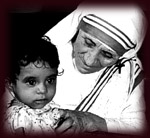Sainthood |
|
HOMEPAGE |
Attaining Sainthood |
|
Mother Teresa was a living saint and one of the most acclaimed holy people of all time. But what will be involved in her officially being named a saint? Shortly after Mother Teresa's passing, Cardinal Roger Mahony of the Catholic archdiocese of Los Angeles, recommended to Rome that the Pope break the rule requiring a five-year wait after death to begin the process of sainthood. In March of 1999, the Holy Father waived the five-year stipulation for beginning the process of canonization. The formal process of sainthood involves a complicated process taking time, money, testimonies, and miracles, and the church follows a strict set of rules in the process. First, to determine who qualifies, the Vatican looks to its Congregation for the "Causes of Saints". Typically, a would-be candidate's "cause" is presented to the local bishop by his or her admirers who persuade him that the life of the candidate was a model of holiness. Once the applicant is approved as a candidate, an appointed postulator interviews those who knew the individual. Personal testimonies, letters, and writings of the candidate's are put together. A relater then sifts through this information and prepares a position paper. If the volumes of evidence prove a life of "heroic virtue", the person is given the title "venerable" by the Pope. The next title, beatified (blessed), is attained if it can be proven that a miracle occurred after the death of the candidate, the result of someone praying to that person for help. To finalize a canonization, it must be established that a second miracle occurred. (Martyrs are the exception. The pope can reduce their miracle requirement to one or waive it altogether.) Most often prayer requests are for a physical healing. Verifying a miracle is considered the most difficult hurdle in the
process. Just deciding what constitutes one causes debate. A life of heroic virtue is
obviously easier to establish than a healing that results from prayers. |






